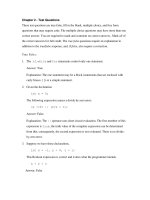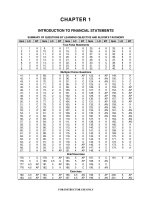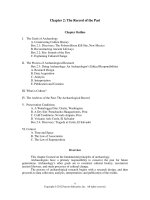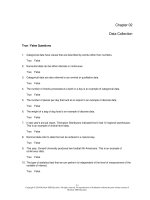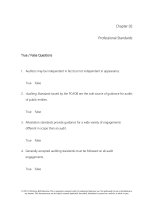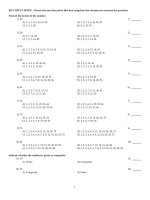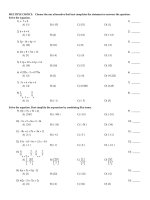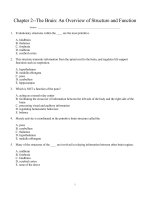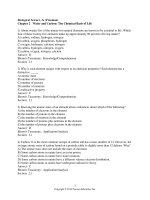ECON MACRO 5th edition mceachern test bank
Bạn đang xem bản rút gọn của tài liệu. Xem và tải ngay bản đầy đủ của tài liệu tại đây (164.85 KB, 50 trang )
Chapter 02 Economic Tools and Economic Systems
TRUEFALSE
1. Opportunity cost is the difference between the benefits and the costs of a choice.
(A) True
(B) False
Answer : (B)
2. Opportunity cost is always measured in dollar terms, rather than in terms of real goods and
services.
(A) True
(B) False
Answer : (B)
3. The opportunity cost of going to college consists of more than just the tuition that will be paid.
(A) True
(B) False
Answer : (B)
4. A rational decision maker engages in an activity if that activity is more attractive than the best
alternative.
(A) True
(B) False
Answer : (A)
5. The Sultan of Brunei, one of the world's richest people, does not face the problem of scarcity.
(A) True
(B) False
Answer : (B)
6. The opportunity cost of going to college is the same for all students who are receiving full-tuition
scholarships.
(A) True
(B) False
Answer : (B)
7. Opportunity cost is objective; therefore, its value does not change as circumstances change.
(A) True
(B) False
Answer : (B)
8. A university should not disband its football team since it has already paid for the stadium.
(A) True
(B) False
Answer : (B)
9. If people specialize in producing those goods for which they possess a comparative advantage,
then an economy as a whole can produce a greater quantity of goods.
(A) True
(B) False
Answer : (A)
10. It is possible for one person to have a comparative advantage in the production of all products.
(A) True
(B) False
Answer : (B)
11. Comparative advantage is based on opportunity costs.
(A) True
(B) False
Answer : (A)
12. A person who can produce more of a good than another person is said to possess a comparative
advantage.
(A) True
(B) False
Answer : (B)
13. It is possible for one person to have an absolute advantage in two tasks and a comparative
advantage in only one.
(A) True
(B) False
Answer : (A)
14. It is possible for one person to have an absolute advantage in something even if she has no
comparative advantage in anything.
(A) True
(B) False
Answer : (B)
15. Absolute advantage is based on opportunity cost.
(A) True
(B) False
Answer : (B)
16. Specialization often leads to gains in productivity for society as a whole.
(A) True
(B) False
Answer : (A)
17. Each point on a production possibilities frontier requires full employment of resources.
(A) True
(B) False
Answer : (A)
18. The production possibilities frontier represents all desirable combinations of outputs.
(A) True
(B) False
Answer : (B)
19. Each point along a nation's production possibilities frontier represents efficient use of all
resources.
(A) True
(B) False
Answer : (A)
20. The production possibilities frontier represents the boundary between attainable and
unattainable prices of commodities.
(A) True
(B) False
Answer : (B)
21. A point inside the production possibilities curve illustrates a situation in which resources are not
fully employed.
(A) True
(B) False
Answer : (A)
22. The bowed-out shape of the production possibilities frontier indicates increasing opportunity
costs.
(A) True
(B) False
Answer : (A)
23. The typical concave (i.e., bowed-out) shape of the production possibilities frontier reflects the
law of increasing opportunity cost.
(A) True
(B) False
Answer : (A)
24. A production possibilities frontier will shift outward if there is an improvement in technology.
(A) True
(B) False
Answer : (A)
25. A production possibilities frontier will shift inward if there is an increase in the size of the labor
force.
(A) True
(B) False
Answer : (B)
26. The economic question of "what to produce" is often referred to as the distribution question.
(A) True
(B) False
Answer : (B)
27. A command economic system does not need to be concerned with what to produce, how to
produce things, or who will get the goods and services produced.
(A) True
(B) False
Answer : (B)
28. Of the various types of economic systems, pure market capitalism involves the greatest
government interference and control over the economy.
(A) True
(B) False
Answer : (B)
29. One flaw of pure capitalism is that a person who owns no resources could starve.
(A) True
(B) False
Answer : (A)
30. Inefficiency is a flaw of a command economy because there is less incentive for resources to flow
to their highest-valued uses.
(A) True
(B) False
Answer : (A)
31. The primary differences in economic structure among different countries relate to ownership of
resources and the manner in which economic activities are coordinated.
(A) True
(B) False
Answer : (A)
MULTICHOICE
32. Opportunity cost exists because:
(A) technology is fixed at any point in time.
(B) the law of comparative advantage is working.
(C) resources are scarce but wants are unlimited.
(D) the value of lost opportunities varies from person to person.
(E) efficiency is measured by the monetary cost of an activity.
Answer : (C)
33. Opportunity cost is defined as the:
(A) dollar cost of what is purchased.
(B) value of all alternatives not chosen.
(C) value of the best alternative not chosen.
(D) difference between the benefits from a choice and the benefits from the next best alternative.
(E) difference between the benefits from a choice and the costs of that choice.
Answer : (C)
34. Suppose you have an hour before your next class starts. You can either read a book, get
something to eat, or take a nap. The opportunity cost of getting something to eat is:
(A) the cost of what you eat.
(B) the value of reading and sleeping.
(C) the loss of value from not reading or sleeping.
(D) the net benefit of sleeping for another hour.
(E) impossible to determine because the most preferred alternative is not known.
Answer : (E)
35. The opportunity cost of an activity:
(A) depends on an individual's subjective values and opinions.
(B) is the same for everyone.
(C) must be calculated and known before undertaking that activity.
(D) is irrelevant to decision making.
(E) is not related to time.
Answer : (A)
36. The opportunity cost of choosing a particular activity:
(A) can be easily and accurately calculated.
(B) cannot be estimated.
(C) does not change over time.
(D) varies depending on time and circumstances.
(E) is measured by the money spent on the activity.
Answer : (D)
37. Suppose you have a choice of working full-time during the summer or going full-time to summer
school. Summer tuition and books are $2,200. If you worked, you could make $7,000. Your rent is
$1,000 for the summer, regardless of your choice. If these are the only relevant costs to consider,
the opportunity cost of going to summer school is:
(A) $2,200.
(B) $7,000.
(C) $8,000.
(D) $9,200.
(E) $10,200.
Answer : (D)
38. A test is scheduled for Monday morning, and you went to a party on Sunday night. If you hadn't
attended the party, you could have studied for the test or gone to a movie. Which of the following is
true regarding your opportunity cost?
(A) The opportunity cost of going to the movie is studying for the test.
(B) The opportunity cost of going to the party is watching the movie.
(C) The opportunity cost of going to the party is both watching the movie and the study time.
(D) Because you could go to the party only that night, but could go to a movie any time, the
opportunity cost of the party is the study time.
(E) From the above information, it's not possible to determine the opportunity cost of attending the
party.
Answer : (E)
39. The term opportunity cost suggests that:
(A) in any exchange situation where one person gains, someone else must lose.
(B) not all individuals make the most of life's opportunities.
(C) executives do not always recognize opportunities for profit as quickly as they should.
(D) the only factor that is important in decision making is cost.
(E) because goods are scarce, in order to get some good you must give up some other good in
return.
Answer : (E)
40. If you enjoy playing golf, the opportunity cost of cleaning your room:
(A) is greater on sunny days than it is on rainy days.
(B) is the same on sunny days as it is on rainy days.
(C) is smaller on sunny days than it is on rainy days.
(D) does not change with weather conditions.
(E) is equal to the opportunity cost of any other chore you have to do that day.
Answer : (A)
41. Melissa is a self-employed lawyer who chooses a higher-priced restaurant 2 miles from home
over a cheaper restaurant 15 miles from home. Which of the following is the most likely explanation
for her behavior?
(A) The opportunity cost of her time is very low.
(B) She doesn't take travel time into consideration.
(C) She doesn't like to cook or doesn't know how to cook.
(D) The prices at the more expensive restaurant understate the opportunity cost of eating there.
(E) The higher monetary cost of the more expensive restaurant is offset by the higher opportunity
cost of the lower-priced restaurant.
Answer : (E)
42. The opportunity cost of an activity is best measured:
(A) only by the monetary costs.
(B) by the number of alternative activities that were forgone.
(C) by the cost difference between the chosen activity and the next best alternative.
(D) by the value expected from the best alternative that is forgone.
(E) as the time wasted choosing among various activities.
Answer : (D)
43. Suppose you have purchased a nonrefundable plane ticket and, at the last moment, cannot take
the trip. You can, however, sell the ticket. If you paid $700 for the ticket, the cost of sending the
ticket to someone through overnight mail is $20, and you spend $10 on a courier to get the ticket to
the post office for overnight delivery, what is the minimum you should accept for the ticket?
(A) $700 because that is what the ticket cost
(B) $720 because that is the cost of the ticket and of getting it to the buyer
(C) $730 because that is the total cost of the ticket and getting it to the buyer
(D) More than $730, so that you can make a profit
(E) $30 because the $700 is a sunk cost
Answer : (E)
44. Sunk costs:
(A) can only be measured in monetary terms.
(B) are opportunity costs.
(C) should influence a person's choice if that person is a marginal decision maker.
(D) lower the efficiency of production.
(E) should not be considered when making economic decisions.
Answer : (E)
45. The law of comparative advantage says that a person should produce a good if he or she:
(A) has the greatest desire to consume that good.
(B) has the lowest opportunity cost of producing that good.
(C) has an absolute advantage in a related activity.
(D) has a comparative advantage in a related activity.
(E) is equally good at producing this good as someone else is.
Answer : (B)
46. The law of comparative advantage does not apply to:
(A) entire nations.
(B) natural resources like air and sunshine.
(C) individuals.
(D) firms.
(E) regions of a country.
Answer : (B)
47. The law of comparative advantage says that:
(A) the individual with the lowest opportunity cost of producing a particular good should produce it.
(B) comparative advantage exists only when one person has an absolute advantage in the production
of two goods.
(C) whoever has a comparative advantage in producing a good also has an absolute advantage in
producing that good.
(D) whoever has an absolute advantage in producing a good also has a comparative advantage in
producing that good.
(E) gains from trade are possible only when one person has a comparative advantage in producing
both goods.
Answer : (A)
48. Comparative advantage refers to:
(A) the ability of an individual to specialize and produce a greater amount of some good than another
individual.
(B) the number of units of a good given up in order to acquire something.
(C) the ability of an individual to produce a good at a lower opportunity cost than some other
individual can.
(D) the amount of labor a particular individual needs to produce a fixed amount of capital goods.
(E) the ability of an individual to produce a good using fewer labor hours than other individuals.
Answer : (C)
49. The law of comparative advantage states that the person who should produce a good is the
person who:
(A) has the lowest opportunity cost of producing that good.
(B) can produce that good using the fewest resources.
(C) will produce that good using the most expensive resources.
(D) has the most desire for that good.
(E) has produced that good in the past.
Answer : (A)
50. John takes 10 minutes to iron a shirt and 20 minutes to type a paper. Harry takes 10 minutes to
iron a shirt and 30 minutes to type a paper. Which of the following statements is correct?
(A) Harry has a comparative advantage in ironing.
(B) Harry has a comparative advantage in typing.
(C) Harry has an absolute advantage in typing.
(D) Harry has an absolute advantage in ironing.
(E) Neither can gain from specialization and exchange.
Answer : (A)
51. Don can produce 10 pens or 20 pencils in one hour while Bob can produce 5 pencils or 15 pens
in one hour. Which of the following statements is correct?
(A) Bob has an absolute advantage over Don in the production of pencils.
(B) Bob has an absolute advantage over Don in the production of pens.
(C) Bob has a comparative advantage over Don in the production of pencils.
(D) Don has a comparative advantage over Bob in the production of pens.
(E) Don does not have a comparative advantage in the production of either good.
Answer : (B)
52. If Jason can wash a car in 20 minutes and wash a dog in 10 minutes and Megan can wash a car
in 15 minutes and wash a dog in 15 minutes, which of the following statements is true?:
(A) The opportunity cost of washing a car is greater for Megan.
(B) The opportunity cost of washing a car is one dog bath for Jason.
(C) Megan could wash two cars in the time it takes Josh to wash a dog.
(D) Jason has both a comparative and an absolute advantage in washing a dog.
(E) The opportunity cost of washing a dog is lower for Jason.
Answer : (D)
53. Janis mows the lawn in 1 hour and types a paper in 1 hour. Kristen mows the lawn in 2 hours
and types a paper in 1 hour. Which of the following statements is true?
(A) Kristen has an absolute advantage in typing and a comparative advantage in mowing.
(B) Janis has an absolute advantage in both activities and a comparative advantage in typing.
(C) Janis has an absolute advantage in both activities and a comparative advantage in mowing.
(D) The opportunity cost of mowing the lawn is greater for Kristen than it is for Janis.
(E) Neither Janis nor Kristen would gain from specialization.
Answer : (D)
54. If Monica has a comparative advantage in baking and George has a comparative advantage in
sewing, then:
(A) Monica must have an absolute advantage in baking.
(B) Monica must have an absolute advantage in sewing.
(C) George must have an absolute advantage in baking.
(D) George must have an absolute advantage in sewing.
(E) we can conclude nothing about absolute advantage.
Answer : (E)
55. If Evan has an absolute advantage in cleaning and bookkeeping when compared to Gloria, then:
(A) Evan must also have a comparative advantage in cleaning and bookkeeping.
(B) Evan must have a comparative advantage in cleaning.
(C) Evan must have a comparative advantage in bookkeeping.
(D) Gloria has a comparative advantage in neither activity.
(E) we can conclude nothing about comparative advantage.
Answer : (E)
56. If Jeremy has an absolute advantage in cooking and Margaret has an absolute advantage in
cleaning, then:
(A) Jeremy has a comparative advantage in cooking and Margaret has a comparative advantage in
cleaning.
(B) Jeremy has a comparative advantage in cleaning and Margaret has a comparative advantage in
cooking.
(C) Margaret has a comparative advantage in cleaning, but we can conclude nothing about Jeremy.
(D) Jeremy has a comparative advantage in cooking, but we can conclude nothing about Margaret.
(E) we can conclude nothing about comparative advantage.
Answer : (E)
57. If Robin has an absolute advantage in both gardening and baking when compared to Robert,
then:
(A) Robin cannot benefit by trading with Robert.
(B) Robin can benefit by specializing in gardening if Robert specializes in baking.
(C) Robin can benefit by specializing in baking if Robert specializes in gardening.
(D) Robin and Robert may benefit from trading, but there is insufficient information to determine
who should specialize in what.
(E) neither Robin nor Robert can benefit from trading with the other.
Answer : (D)
58. If one person has an absolute advantage in producing both of two goods, then that person:
(A) must also have a comparative advantage in both goods.
(B) cannot benefit from trade.
(C) cannot have a comparative advantage in either good.
(D) will have a comparative advantage in only one good.
(E) should specialize in the production of both goods.
Answer : (D)
59. A country has an absolute advantage in the production of a good if that country:
(A) can produce the good using fewer resources than another country would require.
(B) has the lowest opportunity cost of producing the good and can produce it with the fewest
resources.
(C) has the lowest opportunity cost of producing the good, regardless of whether it is produced with
the fewest resources.
(D) has the greatest opportunity cost of producing the good, regardless of whether it is produced
with the fewest resources.
(E) has the greatest opportunity cost of producing the good and produces it with the fewest
resources.
Answer : (A)
60. If Sam can chop up more carrots per minute than Joe can, then:
(A) Joe has an absolute advantage in carrot chopping.
(B) Joe must have a comparative advantage in carrot chopping.
(C) Sam has an absolute advantage in carrot chopping.
(D) Sam must have a comparative advantage in carrot chopping.
(E) we can conclude nothing about absolute advantage.
Answer : (C)
61. Eileen has a comparative advantage over Jan in piano tuning, but not shoe polishing. Therefore,
_____.
(A) Jan must have an absolute advantage in piano tuning
(B) Eileen must have an absolute advantage in shoe polishing
(C) Jan must have a lower opportunity cost of shoe polishing
(D) Eileen must have an absolute advantage in shoe polishing and in piano tuning
(E) Eileen must have an absolute advantage in piano tuning
Answer : (C)
62. If Helen can paint one room in the time it takes her to bake 40 cakes and Josh can paint one
room in the time it takes him to bake 60 cakes, which of the following is true?
(A) The opportunity cost of painting is higher for Helen.
(B) The opportunity cost of baking cakes is lower for Josh.
(C) The opportunity cost of painting one room is 1/40 of a cake for Helen.
(D) The opportunity cost of baking one cake is 60 rooms painted for Josh.
(E) The opportunity cost of cakes cannot be computed.
Answer : (B)
63. If Helen can paint one room in the time it takes her to bake 40 cakes and Josh can paint one
room in the time it takes him to bake 60 cakes, Helen's opportunity cost of baking one cake is:
(A) painting one room.
(B) painting 1/40 of a room.
(C) painting 1/60 of a room.
(D) painting 2/3 of a room.
(E) painting 3/2 of a room.
Answer : (B)
64. If Helen can paint one room in the time it takes her to bake 40 cakes and Josh can paint one
room in the time it takes him to bake 60 cakes, Josh's opportunity cost of baking one cake is:
(A) painting one room.
(B) painting 1/40 of a room.
(C) painting 1/60 of a room.
(D) painting 2/3 of a room.
(E) painting 3/2 of a room.
Answer : (C)
65. If Daniel produces one pair of shoes in 4 hours and Sarah produces one pair of shoes in 3 hours,
then:
(A) Sarah has a comparative advantage in shoemaking.
(B) Daniel has a comparative advantage in shoemaking.
(C) Sarah has an absolute and a comparative advantage in shoemaking.
(D) Daniel has an absolute and a comparative advantage in shoemaking.
(E) Sarah has an absolute advantage in shoemaking.
Answer : (E)
66. Hans can do 4 loads of laundry per hour, and he can type 6 pages per hour. Maria can do 12
loads of laundry per hour, and she can type 8 pages per hour. Hans' opportunity cost of doing one
load of laundry is:
(A) 12 papers.
(B) 8 papers.
(C) 1 1/2 pages.
(D) 2/3 of a page.
(E) impossible to compute without additional information.
Answer : (C)
67. Hans can do 4 loads of laundry per hour, and he can type 6 pages per hour. Maria can do 12
loads of laundry per hour, and she can type 8 pages per hour. Hans' opportunity cost of typing one
page is:
(A) 12 loads of laundry.
(B) 8 loads of laundry.
(C) 3/2 of a load of laundry.
(D) 2/3 of a load of laundry.
(E) impossible to compute without additional information.
Answer : (D)
68. Hans can do 4 loads of laundry per hour, and he can type 6 pages per hour. Maria can do 12
loads of laundry per hour, and she can type 8 pages per hour. Maria's opportunity cost of typing one
page is:
(A) 4 loads of laundry.
(B) 6 loads of laundry.
(C) 3/2 of a load of laundry.
(D) 2/3 of a load of laundry.
(E) impossible to compute without additional information.
Answer : (C)
69. Hans can do 4 loads of laundry per hour, and he can type 6 pages per hour. Maria can do 12
loads of laundry per hour, and she can type 8 pages per hour. Maria's opportunity cost of doing one
load of laundry is:
(A) 4 pages.
(B) 6 pages.
(C) 2/3 of a page.
(D) 3/2 of a page.
(E) impossible to compute without additional information.
Answer : (C)
70. Hans can do 4 loads of laundry per hour, and he can type 6 pages per hour. Maria can do 12
loads of laundry per hour, and she can type 8 pages per hour. In any given amount of time, _____.
(A) Maria has both an absolute and a comparative advantage in typing
(B) Maria has both an absolute and a comparative advantage in doing laundry
(C) Maria has a comparative advantage in both typing and doing laundry
(D) Hans has both an absolute and a comparative advantage in typing
(E) Hans has an absolute advantage in doing laundry
Answer : (B)
71. Hans can do 4 loads of laundry per hour, and he can type 6 pages per hour. Maria can do 12
loads of laundry per hour, and she can type 8 pages per hour. Hans and Maria would both be better
off if:
(A) Hans specialized in typing and Maria in doing laundry, trading with each other for the other
service.
(B) Hans specialized in doing laundry and Maria in typing, trading with each other for the other
service.
(C) each did their own laundry and typing.
(D) Maria did all of the typing and all of the laundry.
(E) Hans did all of the typing and all of the laundry.
Answer : (A)
72. In one week, Mohammed can knit 5 sweaters or bake 240 cookies. In one week, Aisha can knit
15 sweaters or bake 480 cookies. Which of the following is correct?
(A) Mohammed has an absolute and comparative advantage in both tasks.
(B) Aisha has an absolute and comparative advantage in both tasks.
(C) Mohammed has an absolute advantage in both tasks and a comparative advantage in knitting
sweaters.
(D) Aisha has an absolute advantage in both tasks and a comparative advantage in knitting sweaters.
(E) Mohammed has an absolute advantage in both tasks and a comparative advantage in baking
cookies.
Answer : (D)
73. In one week, Mohammed can knit 5 sweaters or bake 240 cookies. In one week, Aisha can knit
15 sweaters or bake 480 cookies. Mohammed's opportunity cost of knitting one sweater is:
(A) 480 cookies.
(B) 240 cookies.
(C) 48 sweaters.
(D) 1/48 of a cookie.
(E) 48 cookies.
Answer : (E)
74. In one week, Mohammed can knit 5 sweaters or bake 240 cookies. In one week, Aisha can knit
15 sweaters or bake 480 cookies. Mohammed's opportunity cost baking one cookie is:
(A) 1 sweater.
(B) 5 sweaters.
(C) 48 sweaters.
(D) 1/48 of a sweater.
(E) 48 cookies.
Answer : (D)
75. In one week, Mohammed can knit 5 sweaters or bake 240 cookies. In one week, Aisha can knit
15 sweaters or bake 480 cookies. Mohammed and Aisha would produce the maximum quantities of
both cookies and sweaters if:
(A) Mohammed knitted and baked and Aisha did nothing.
(B) Aisha knitted and baked and Mohammed did nothing.
(C) Mohammed knitted and Aisha baked.
(D) Aisha knitted and Mohammed baked.
(E) Mohammed knitted and baked and Aisha just knitted.
Answer : (D)
76. In one week, Mohammed can knit 5 sweaters or bake 240 cookies. In one week, Aisha can knit
15 sweaters or bake 480 cookies. Aisha's opportunity cost of knitting one sweater is:
(A) 240 cookies.
(B) 480 cookies.
(C) 32 cookies.
(D) 1/32 of a cookie.
(E) 16 cookies.
Answer : (C)
77. In one week, Mohammed can knit 5 sweaters or bake 240 cookies. In one week, Aisha can knit
15 sweaters or bake 480 cookies. Aisha's opportunity cost of baking one cookie is:
(A) 5 sweaters.
(B) 15 sweaters.
(C) 32 sweaters.
(D) 1/32 of a sweater.
(E) 480 sweaters.
Answer : (D)
78. The figure below shows the production possibilities frontiers for rice and T-shirts for two
countries, Costa Rica and United States. According to the figure below, in Costa Rica, the
opportunity cost of 1 ton of rice is:
Figure 2.1
(A) 1/2 of a T-shirt.
(B) 3/4 of a T-shirt.
(C) 1 T-shirt.
(D) 11/2 T-shirts.
(E) 2 T-shirts.
Answer : (C)
79. Barter occurs when:
(A) two people share everything.
(B) one product is exchanged directly for another product.
(C) money is used to buy goods.
(D) money is exchanged directly for other money.
(E) goods are used to buy money.
Answer : (B)
80. Bill trades a ginger snap for a chocolate chip cookie. This is an example of:
(A) barter.
(B) specialization.
(C) absolute advantage.
(D) privatization.
(E) the division of labor.
Answer : (A)
81. Money facilitates trade because:
(A) it eliminates the need for specialization.
(B) it prevents people from taking advantage of each other.
(C) it serves as a medium of exchange.
(D) the division of labor allows money to be produced at a lower cost.
(E) people do not benefit from barter unless money is used.
Answer : (C)
82. Barter is:
(A) illegal in the United States.
(B) an efficient system of exchange.
(C) most useful when there is much specialization and international trade.
(D) only possible if money is used as a medium of exchange.
(E) the direct exchange of goods without the use of money.
Answer : (E)
83. A medium of exchange must be:
(A) approved by the government.
(B) universally acceptable in exchange for goods and services.
(C) easy to reproduce.
(D) used to eliminate the specialization and division of labor.
(E) used when a system of barter exists.
Answer : (B)
84. All of the following are evidences of specialization except:
(A) a carpenter who builds an entire bedroom set without any help from others.
(B) a restaurant that provides continental and oriental food in all its outlets.
(C) the credits at the end of a movie.
(D) professional mourners in Taiwan.
(E) online sellers.
Answer : (A)
85. Which of the following provides the best evidence of the specialization of labor?
(A) A firm that produces a line of related products, such as eight kinds of breakfast cereal
(B) An architect who is willing to practice in only one geographic area
(C) A physician who practices in a specialty area such as cardiology or orthopedic surgery
(D) A family that eats at Wendy's every Thursday night
(E) A retailer who sells goods but provides no services
Answer : (A)
86. The division of labor:
(A) allows more people to be employed.
(B) allows tasks to be performed more efficiently.
(C) makes people happier on the job.
(D) means that less management is required.
(E) means that less equipment will be used.
Answer : (B)
87. The division of labor facilitates productivity increases for all of the following reasons, except
one. Which is the exception?
(A) It allows people to do those tasks for which they have the greatest natural ability.
(B) Workers get better at tasks the more they repeat them.
(C) The more experience workers gain by specializing in a task, the more likely they will enjoy that
task.
(D) More sophisticated production techniques are introduced.
(E) It often permits the introduction of labor-saving machinery.
Answer : (C)
88. Which of the following is not a gain from division of labor?
(A) Workers' abilities are matched to tasks.
(B) Workers gain experience from the repetition of the tasks.
(C) Workers save time by not moving to different tasks.
(D) Workers' morale increases as tasks become more specialized.
(E) The introduction of labor-saving machinery is possible.
Answer : (D)
89. The division of labor increases productivity because:
(A) tasks can be assigned according to individual abilities.
(B) workers who repeatedly perform the same tasks become bored.
(C) each worker must learn each of the numerous tasks in the total production process.
(D) the specialization of labor allows for the introduction of cheaper, less sophisticated production
techniques.
(E) managers can force workers to produce goods that are valued higher than the costs of producing
them.
Answer : (A)
90. The division of labor refers to:
(A) discrimination in labor markets.
(B) separating a job into smaller tasks completed by different people.
(C) one worker who divides his time among different jobs and duties.
(D) defining a job according to the appropriate sex of the worker.
(E) the fact that two 20-year-olds are more productive than one 40-year-old.
Answer : (B)
91. The specialization of labor:
(A) increases productivity without creating any problems.
(B) reduces productivity and is usually eliminated by business firms.
(C) can create problems of boredom and repetitive motion injuries.
(D) prevents the introduction of more sophisticated and efficient production techniques.
(E) ignores individual preferences and natural abilities.
Answer : (C)
92. In economics, specialization means:
(A) producing something using only one type of natural resource.
(B) producing something using only labor.
(C) focusing efforts on a particular product or a single task.
(D) producing only one unit of output.
(E) producing something using only one unit of a variable resource.
Answer : (C)
93. Which of the following is an example of the division of labor?
(A) An author writing a book one chapter at a time
(B) A firm trying to get rid of a labor union
(C) Separating resources into four categories: land, labor, capital, and entrepreneurial ability
(D) Allocating revenue among a firm's resource suppliers
(E) Dividing an assembly process into separate steps
Answer : (E)
94. On a given production possibilities frontier, which of the following is not assumed to be fixed?
(A) The amount of labor available
(B) The amount of capital available
(C) The level of technology
(D) The amount of land and natural resources available
(E) Production of each item
Answer : (E)
95. At all points along the production possibilities frontier, _____.
(A) the greatest achievable output levels are illustrated
(B) resources are not fully employed
(C) more of one good can be obtained without giving up more of the other
(D) more efficient output levels are possible
(E) society is equally well off
Answer : (A)
96. When drawing a production possibilities frontier for two goods, all of the following are usually
assumed except one. Which is the exception?
(A) The quantity of resources is rapidly growing.
(B) Technology is fixed.
(C) Resources can be shifted from the production of one good to the other.
(D) The production possibilities frontier is drawn for a particular time period.
(E) Resources are fully and efficiently employed.
Answer : (A)
97. An economy's production possibilities frontier:
(A) helps explain the immense complexity of the real economy.
